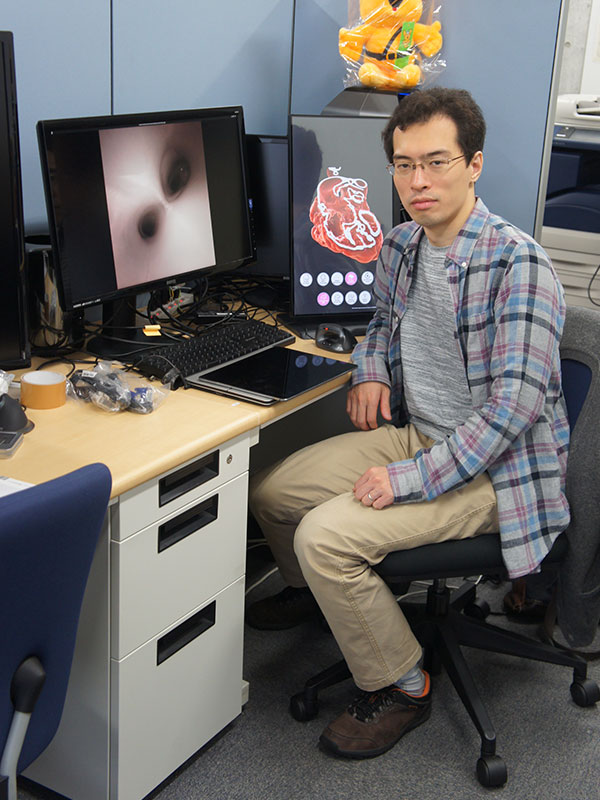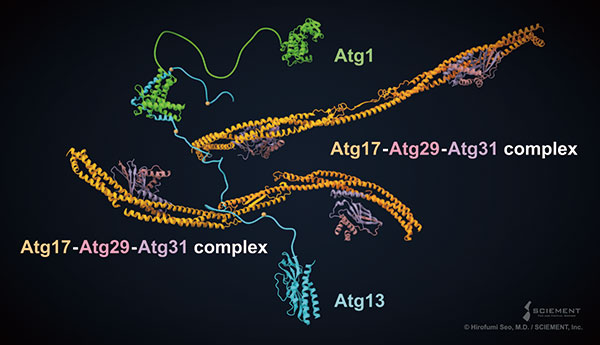Fun and factual science Conveyed by a CG designer who has a medical license

UTokyo 30s
Up-and-coming young entrepreneurs
Of the more than 350 University of Tokyo spin-off ventures, we have chosen to feature those by seven energetic young entrepreneurs in their 30s. Four of these companies are located in the venture support facilities on the Hongo Campus, one in the support facilities on the Kashiwa Campus, and one each in the Tokyo neighborhoods of Otemachi and Gotanda. How do these young people go about their daily work, and what kind of people are they? A few glimpses are presented here.
| Medical computer graphics content creation |
Fun and factual science
Conveyed by a CG designer who has a medical license


The company name, SCIEMENT, is a combination of “science” and “entertainment.” What Hirofumi Seo founded is a company that creates 3D computer graphics (CG) content concerning science, and medical science in particular. The initial seed was planted in 1999 when he watched “The Universe Within III - The Human Genome” series on NHK, Japan’s public broadcaster. This TV science series made of music and CG animations that were the state of the art at the time had a huge impact on Seo, then a second-year middle school student who was experimenting with coding 3DCG in a PC club, and fostered a desire within him to make similar TV programs. Believing a medical department to be ideal for learning about the human body, Seo enrolled in the University of Tokyo undergraduate course Natural Sciences III, which is considered to be a prerequisite for entering the Faculty of Medicine. At the same time, he chose to enroll in a technical school to study 3DCG.
“I also went to Digital Hollywood School for a year, learning the skills for creating CG works. During this period, I was attending the two schools at the same time. But since I had already earned two years of credits in the College of Arts and Sciences in advance, there were no problems.”
On course with his initial plan, he went on to study in the Faculty of Medicine, where his encounter with forensic medicine was a significant event. It was just before the start of the lay judge system in Japan. As fate would have it, his tutor was involved in a forensic autopsy on the victim of the first lay judge trial of a murder case, and Seo created a 3DCG image showing the state of the victim’s wounds. The image was adopted as evidence in court.
“I won the (UTokyo) President’s Grand Award for this accomplishment. It meant a lot to be recognized not for extracurricular activities but in the academic area. It was also significant to learn that 3DCG could be of use in areas other than TV programs.”
After he graduated from the Faculty of Medicine and acquired a medical practitioner’s license, he became an intern doctor at the University of Tokyo Hospital, believing there would be things that he could learn by working as a physician. As he went around various clinical departments over a two-year period, he discovered there were 3DCG demands at the medical frontline.
“My superior in the Department of Respiratory Medicine wanted to practice using a bronchoscope, so I made a model of the bronchial tubes using a 3D printer. I decided to make this into a game played out on a screen, resulting in ‘Kikanshi de Go!’ (“Go by Bronchi”; provisional name). By controlling the scope’s direction as it advances, you gain a natural understanding of the structure of the bronchial tubes. I came to realize that 3DCG linked to your own operations is useful in medical care practice.”
After his work as an intern came to an end, he finally took a major step towards fulfilling his longstanding desire to combine science and entertainment, creating SCIEMENT. Initially, the company was mostly engaged in 3D computer graphics video materials, including materials used in a music video for pop singer Kaela Kimura and in a TV drama. Currently, however, its main content is medical 3D computer graphics software, advancing the methodology that went into making “Kikanshi de Go!” For instance, a simulator that uses 3D data from the patient’s own CT images to allow the user to easily check all kinds of cross-sections of organs has started trial use at the Kanagawa Children’s Medical Center. While receiving feedback from the medical frontline, Seo is pursuing commercialization of this simulator and other products, armed with his two specialties of computer graphics and medicine. Even though the content has changed, the company’s slogan, “Fun and Factual Science,” remains the same.

| Q & A | |
|---|---|
| Out of your 3DCG videos, what piece do you consider to be the most significant? | “The Yoshinori Ohsumi Nobel Lecture video, which I created after talking with Ohsumi directly.” |
| Were you also a Project Academic Support Specialist at the Graduate School of Information Science and Technology? | “Yes, until the end of July (2019), I was in charge of developing brain surgery software in the Igarashi Laboratory.” |
| What club did you belong to as a student? | “The Tetsumon (Faculty of Medicine students’) Volleyball Club. Being able to jump 90 cm straight up, I was good at blocking.” |
| How do you feel now that you are in your 30s? How do you spend your days off? | “My lecture speed isn’t as fast as it once was.” “Going for walks with my family and going out to eat.” |
* This article was originally printed in Tansei 39 (Japanese language only). All information in this article is as of September 2019.



 Hirofumi Seo
Hirofumi Seo


